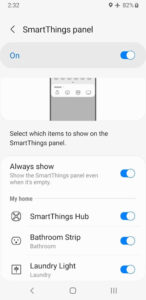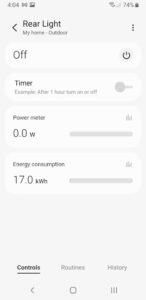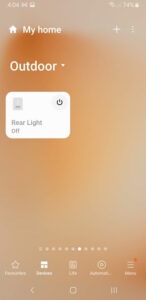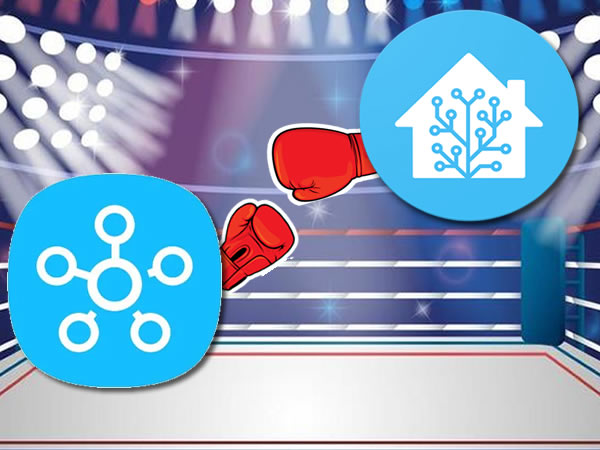 Regular readers of my blog will know that my smart home is powered by Home Assistant, what I have not mentioned before is that I have been a closet user of a SmartThings hub. Below, I will document my experiences of using it with Home Assistant and my thoughts about the SmartThings platform.
Regular readers of my blog will know that my smart home is powered by Home Assistant, what I have not mentioned before is that I have been a closet user of a SmartThings hub. Below, I will document my experiences of using it with Home Assistant and my thoughts about the SmartThings platform.
To start with, I will explain my reasoning on purchasing a SmartThings hub after being a Home Assistant user for a number of years. My decision to purchase the hub came down to cost, location and timing. I purchased the hub on sale a few years back for under $100AU, knowing that Home Assistant had recently added smart things as an integration I thought this would be a good way to add Z-Wave to my set-up (Z-Wave sticks in Australia were a bit over 100 at the time) as well as possibly upgrade my Zigbee setup from the CC2531 stick I was using at the time. I also thought it may be a good backup device in case my Home Assistant setup ever went down.
A Raspberry Pi 3 next to a SmartThings Hub V3
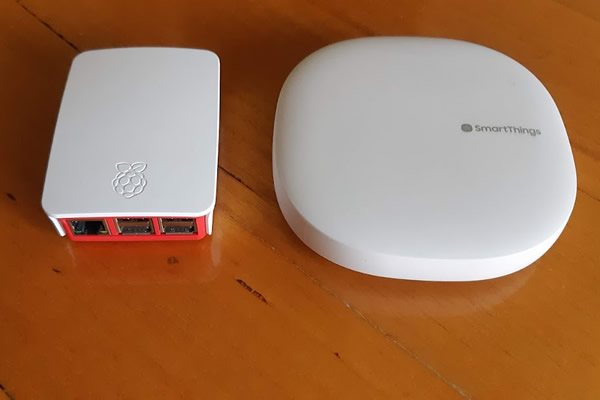
Setup of the SmartThings Hub
Setup of the SmartThings hub was pretty straight forward and is all done via their app. At the there were two apps in the play store, a classic app and a new SmartThings app, a situation that came about after SmartThings transition to a Samsung owned company. Different sets of features were available across each app platform, which made for a confusing experience, but I believe this may have been ironed out by now with the legacy app now retired. Adding Z-Wave devices was pretty straight forward, while adding my Aqara Zigbee devices required adding custom device handlers via their web based developer portal. This was a bit of mucking around to be honest and not something their target market would enjoy or maybe capable of doing. While it was simple enough for me to do with an IT background, in the end I removed all my Aqara sensors from the SmartThings hub as most of them went off-line without warning fairly regularly. On the other hand, my Tasmota flashed LED strip also required a custom device handler, but its connection to the hub was rock solid.
Screenshots of the SmartThings App
Using the SmartThings Hub with Home Assistant
Since February 2019, a SmartThings integration has been available for Home Assistant, it was this addition that prompted me to purchase the hub once I saw it on sale a few months later. Prior to this, a hacky method via MQTT was used to communicate between the two platforms (I did try to set this up, but I had not much success). Setting up the Home Assistant SmartThings integration was pretty straight forward and required generating a token on your SmartThings account page as outlined here. One thing to note is that this integration is only one way, with your SmartThings paired devices ending up in Home Assistant and not the other way around. Performance wise at first I was not too impressed as it seemed a bit slow to turn on my Z-Wave lights, although improvements to Samsung’s platform and cloud did improve things later on. In the end, I was only using the SmartThings hub to control three Z-Wave lights.
My thoughts on the SmartThings Hub
Earlier in this post, I mentioned that location and timing was part of the reason why I had not committed to a stand alone Z-Wave stick solution and prompted me to buy the SmartThings hub. Well, location and timing is probably the reason why I chose Home Assistant as an automation platform over a commercial based hub like SmartThings in the first place. Australia’s market is pretty small and decent products often take a while to be release in our country, had the SmartThings hub been released earlier here I may have committed to it earlier rather than looking for another accessible solution, which ended up being rolling out Home Assistant on a very available at the time Raspberry Pi. While I think it’s a very capable hub, I just don’t think it is for me considering the time I have already invested into Home Assistant and the size of my smart home. If I ever bought a weekend apartment for myself or wanted to put something in my parent’s place to control only a handful of devices, I think this hub would be a great solution. If you are considering a SmartThings hub I would recommend only purchasing gear that is guaranteed to work with SmartThings. In my experience some of my cheaper Chinese IOT devices were not only a pain to add to SmartThings but were also unreliable with it, unlike how they are on Home Assistant.
Wrap up
While I probably don’t need to mention that I am a big fan of Home Assistant, I don’t think it’s fair to compare both products as I believe they target different customers in the same audience. While Home Assistant originally targeted the tinkerer who had the skills to set up Home Assistant on a pi or old PC in the first place, SmartThings has been a box you can plug in and get going via their app in a few minutes. Both are capable of similar tasks given the right amount of smart devices in your home, but I believe SmartThings is probably more aimed at the starter or smaller smart home.
Cost wise you can get a new SmartThings hub for $145AU from Aeotec, while a Raspberry Pi for Home Assistant with a case, PSU and SD card will come close to this, and we have not added a Zigbee or Z-Wave stick to it yet, something that is standard on the SmartThings Hub. (note that Home Assistant are releasing their Home Assistant yellow “ready out of the box” hub wth Zigbee only later in 2022 for US$185).
While you can use the SmartThings hub with Home Assistant as mainly a Z-Wave and or Zigbee radio, I found it didn’t live up to my expectations as it was a bit slow to activate my Z-Wave lights. I eventually gave up on it and bought a separate Z-Wave and newer Zigbee stick to use with Home Assistant directly. In my opinion if you are a tinkerer, and you know you are going to try out cheap, hacked, or Homebrew IOT stuff then start with Home Assistant. If you want to start or stay small, don’t want too much hassle setting things up and are OK with paying a bit extra for your sensors and other things that are known to work with the SmartThings platform, then a SmartThings hub is a great start to building your smart home. As a companion device to Home Assistant, the SmartThings hub is OK, but not brilliant.
